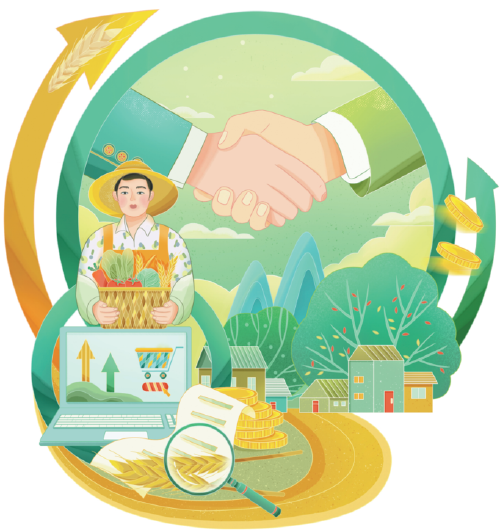Unlocking the potential of smallholder farmers
The current global food crisis underscores the urgent need to transform local food systems and rural livelihoods

The current global food crisis underscores the urgent need to transform local food systems and rural livelihoods

Smallholder farmers, delivering one-third of food consumed globally, have a particularly important role to play in local food systems and in ending rural poverty and hunger as well as improving nutrition in developing countries, where food insecurity is most acute.
China is characterized as a large country with numerous smallholder farmers. According to data from China's third agricultural census conducted in 2020, smallholder farmers account for 90 percent of the agricultural workforce and cultivate over 70 percent of arable land in China. Given their importance, smallholders are the cornerstone of the people-centered approach of the Chinese government in solving the "agriculture, rural areas and farmers" (three rural) issues, which led to the eradication of extreme poverty in 2020 and the rapid social-economic growth in the past 40 years.
Investing in agriculture and small-scale producers has proved to be one of the most effective means for transforming rural livelihoods and creating demands for investment and consumption. It increases production, stimulates private partnerships and contributes to higher incomes, ultimately providing strong support for stable growth and employment. This has long been recognized by the Chinese government, as proved by its prioritizing the "three rural "issues on the agenda of the "No. 1 Central Document" for 20 consecutive years since 2004.
This year's document reemphasizes the government's commitment to giving top priority to the development of agricultural and rural areas, in the attainment of food security and shared prosperity.
Over the past decades, the Chinese government has made significant efforts and gained extensive experience toward attaining these goals. The results have been impressive, with Chinese farmers experiencing rapid income growth in recent years. For instance, in 2019, farmers' income had doubled the 2010 figure, and in 2022 the per capita disposable income of farmers surpassed 20,000 yuan ($2,898) for the first time, reaching 20,133 yuan. Furthermore, the income gap between urban and rural areas has been gradually narrowed.
Based on these remarkable achievements, China is widely regarded as an example of successful development. Its rich agricultural knowledge and practices are viewed as a useful reference for the developing world, particularly for other developing countries facing similar economic and environmental constraints.
For example, smallholder farmers in rural areas have universally been at a major disadvantage in accessing modern value chains, because of lower sales volumes, difficulties to reach markets and inability to meet the standards of many high-value commodities. To tackle this issue, the Chinese government piloted and promoted various mechanisms and approaches to integrate small-scale producers into modern agricultural industries. Among the successful ones, the "digital agribusiness" and "Internet +" projects drastically expand the market of smallholder productions beyond rural areas; and e-commerce direct procurement and e-commerce live broadcast directly connect producers with consumers by increasing visibility and accessibility, which also reduces transaction costs.
These innovative solutions and practices focusing on small-scale producers can be readily adapted, technologically and economically, to other developing contexts to transform their agriculture sectors, rural economies and local food systems. As such, China has partnered with the International Fund for Agricultural Development to promote South-South and Triangular Cooperation in support of shared prosperity. This collaboration led to the establishment of the China-IFAD SSTC Facility in 2018, with a contribution of $10 million from the Chinese government to facilitate the exchange of best practices, proven technologies and conducive policies among developing countries.
Since its establishment, the Facility has impacted over 50,000 smallholder farmers through a variety of initiatives. It has contributed, among others, to the adoption of drip and solar irrigation systems to address climate change in Ethiopia and Rwanda; improved the productive capacity of farmers in the cassava value chain in Congo and Tanzania; enhanced the food and nutrition security of communities in Ghana and Nigeria through the development of cage aquaculture; and promoted climate-resilient value chains in the Mekong region.
Despite the opportunities offered by investing in agriculture and in smallholders to tackle on-going and emerging global challenges, there has been a significant shortage of global investments for this sector. Although the international community has pledged to end hunger by 2030, support from the donor countries for agriculture has been stagnant at just 4 percent of total Official Development Assistance for at least two decades. This situation is mirrored to a more severe extent in our food systems and rural livelihoods, as poverty and hunger have increased since 2019, reversing a long downward trend.
Smallholder farmers are on the frontlines of compounding hardships, including poverty, food insecurity and malnutrition, climate change, COVID-19, biodiversity loss, environmental degradation and social exclusion. The current global food crisis underscores the urgent need to transform local food systems and rural livelihoods. To this end, the international community must unite and mobilize the needed resources to effectively promote agricultural development, building on the success stories that can inspire and accelerate the achievement of a world without hunger and poverty. It is estimated that by 2030, with the right policies and investments, agriculture could unlock an extra $2 trillion in rural growth. IFAD, as the only international financial institution and the United Nations specialized agency with a dedicated mandate on transforming rural economies and food systems, will continue its close collaboration with development partners locally and globally to unlock the potential of smallholder farmers and leave no one behind.

The author is head of South-South and Triangular Cooperation and Global Engagement Unit and special adviser to the president of International Fund for Agricultural Development. The author contributed this article to China Watch, a think tank powered by China Daily.
Contact the editor at editor@chinawatch.cn

































